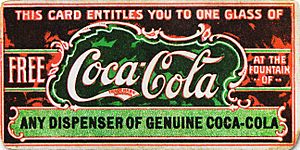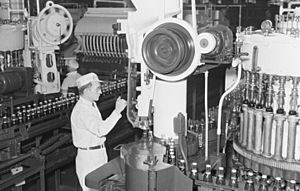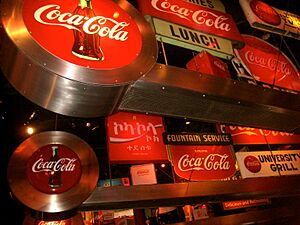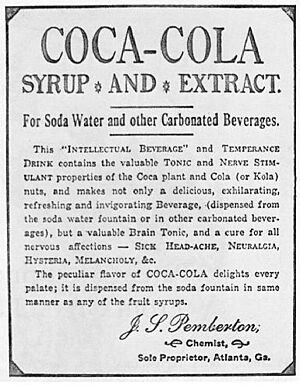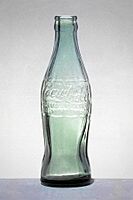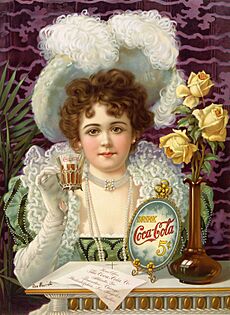Coca-Cola facts for kids
 |
|
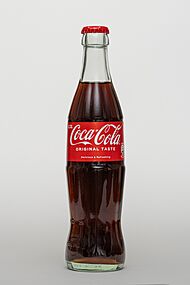
Coca-Cola has retained many of its historical design features in modern glass bottles.
|
|
| Type | Cola |
|---|---|
| Manufacturer | The Coca-Cola Company |
| Country of origin | United States |
| Region of origin | Atlanta, Georgia, U.S. |
| Introduced | May 8, 1886 |
| Color | Caramel E-150d |
| Variants |
|
| Related products | Mojo Pepsi RC Cola Afri-Cola Postobón Inca Kola Kola Real Cavan Cola Est Cola |
Coca-Cola, often called Coke, is a famous cola soft drink made by The Coca-Cola Company. It is one of the most well-known drinks in the world. In 2013, Coke products were sold in over 200 countries. People drink more than 1.8 billion servings of the company's beverages every day.
Coca-Cola was invented in the late 1800s by a pharmacist named John Stith Pemberton in Atlanta, Georgia. At first, it was sold as a health tonic. Later, a businessman named Asa Griggs Candler bought the company. His smart marketing helped make Coca-Cola a top soft drink brand.
The name "Coca-Cola" comes from two of its original ingredients: coca leaves and kola nuts, which are a source of caffeine. The exact recipe for Coca-Cola is a famous trade secret. Only a few people know the complete formula. This secrecy has been a clever marketing tool for the company.
The Coca-Cola Company makes a syrup concentrate. This syrup is sold to licensed bottlers all over the world. The bottlers mix the syrup with filtered water and sweeteners to create the final drink. They then package it in cans and bottles to sell in stores, restaurants, and vending machines.
Over the years, the company has created many other drinks under the Coke name. Some of the most popular are Diet Coke, Coca-Cola Zero Sugar, Coca-Cola Cherry, and Coca-Cola Vanilla.
Contents
The History of Coca-Cola
How Coca-Cola Was Invented
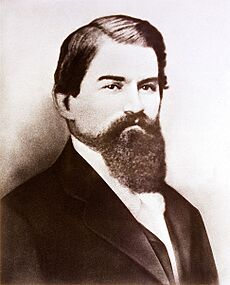
In 1886, a pharmacist named John Stith Pemberton created Coca-Cola in Atlanta, Georgia. At the time, many cities, including Atlanta, had laws against selling alcoholic drinks. Pemberton decided to create a non-alcoholic drink that people could enjoy.
He first sold it at Jacob's Pharmacy on May 8, 1886. A glass of Coca-Cola cost just five cents. At that time, many people believed that carbonated water was good for their health. So, Coca-Cola was advertised as a drink that could help with headaches and feeling tired.
By 1888, different versions of Coca-Cola were being sold. Pemberton sold the rights to his business to Asa Griggs Candler. Candler was a smart businessman who saw great potential in the drink. He used clever marketing to make Coca-Cola popular.
The Coca-Cola Company Is Born
Asa Candler took full control of the Coca-Cola recipe and name. In 1892, he started a new company called The Coca-Cola Company, which is the same company that exists today.
In 1919, a group of investors led by Ernest Woodruff bought the company for $25 million. His son, Robert W. Woodruff, became the president in 1923. Robert Woodruff helped Coca-Cola expand all over the world. He also introduced the "six-pack," making it easier for people to take bottles home.
For a long time, the company wanted people to use the full name, "Coca-Cola." They worried that the nickname "Coke" might be used for other drinks. But in 1941, the company embraced the nickname. "Coke" became an official trademark in 1945.
The First Bottles of Coke
The first time Coca-Cola was put into bottles was on March 12, 1894, in Vicksburg, Mississippi. A candy store owner named Joseph A. Biedenharn was the first to do it.
A few years later, two businessmen from Tennessee, Benjamin F. Thomas and Joseph B. Whitehead, had a great idea. They wanted to bottle Coca-Cola on a much larger scale. They convinced Asa Candler to give them the rights to bottle the drink for only one dollar.
This deal meant that the price of a bottle of Coke stayed at five cents for many years, from 1886 to 1959. The first major bottling company opened in Chattanooga, Tennessee, in 1899.
The "New Coke" Mistake
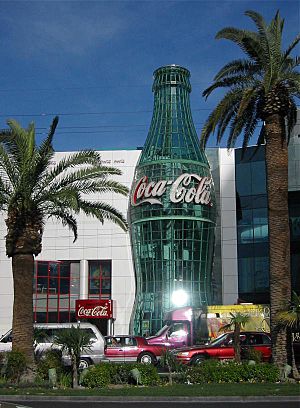
On April 23, 1985, Coca-Cola made a big announcement. They changed the secret formula for the first time in 99 years. The new drink was called "New Coke."
Many people who loved the original Coke were very upset. They missed the old flavor and started protesting. The company received thousands of phone calls and letters from angry customers.
The public reaction was so strong that Coca-Cola quickly changed its mind. On July 10, 1985, just 79 days later, they brought back the original formula. It was renamed "Coca-Cola Classic." The "New Coke" was eventually discontinued. This event showed how much people cared about the classic drink.
How Coca-Cola Is Made
The Secret Formula
The exact recipe for Coca-Cola's natural flavorings is one of the most famous trade secrets in the world. The original copy of the formula was kept in a bank vault for 86 years. In 2011, it was moved to a new vault at the World of Coca-Cola museum in Atlanta, where visitors can see it.
A popular story says that only two executives know the formula, and each one knows only half. However, the company has said that while access is very limited, the executives who know the formula know the whole thing.
What's Inside a Can of Coke?
While the natural flavorings are a secret, the other ingredients are listed on the can. A standard can of Coca-Cola contains:
- Carbonated water
- Sugar (either sucrose or high-fructose corn syrup, depending on the country)
- Caffeine
- Phosphoric acid
- Caramel color (E150d)
- Natural flavorings
Early Ingredients
When Coca-Cola was first created, its two main ingredients were coca leaves and kola nuts. This is how it got its name.
The coca leaf was the source of a substance that was later found to be harmful and is now illegal. In 1903, this substance was removed from the recipe. Since then, Coca-Cola has used special coca leaves that have had the substance taken out. A company in New Jersey is the only one in the U.S. allowed to process these leaves.
Kola nuts were the original source of caffeine in the drink. They also added to the flavor. Today, the amount of caffeine in Coca-Cola is less than in a typical cup of coffee.
The Famous Coca-Cola Bottle
The famous Coca-Cola bottle is called the "contour bottle." It was designed in 1915. The company wanted a bottle that was so unique you could recognize it even in the dark or if it was broken.
A bottle designer named Earl R. Dean from the Root Glass Company in Indiana created the design. He was inspired by a picture of a cocoa pod he saw in an encyclopedia. He thought its ribbed shape would make a great bottle.
The first design was a bit too wide in the middle and was not stable on conveyor belts. Dean slimmed it down, and the new design was chosen in 1916. Today, the contour bottle is a world-famous symbol of Coca-Cola.
Coca-Cola Advertising
Coca-Cola's advertising has had a big impact on American culture. The company is often credited with creating the modern image of Santa Claus as a cheerful man in a red and white suit. Starting in the 1930s, artist Haddon Sundblom painted images of Santa for Coke's winter ads. These paintings became very popular and helped shape how many people see Santa today.
Over the years, Coca-Cola has used many famous slogans, such as:
- "It's the Real Thing"
- "The Pause That Refreshes"
- "I'd Like to Buy the World a Coke"
- "Coke Is It!"
In 1971, the song from a Coke commercial, "I'd Like to Teach the World to Sing", became a worldwide hit.
In 2011, Coca-Cola started a popular campaign in Australia called "Share a Coke." They replaced the logo on bottles with common first names. The idea was for people to find a bottle with their name or a friend's name and share it. The campaign was a huge success and was launched in many other countries.
Coca-Cola Around the World

Coca-Cola is sold in almost every country. The only countries where it is not officially sold are Cuba and North Korea due to long-standing trade restrictions with the United States.
The brand is a major sponsor of global events. It has been a sponsor of the Olympic Games since 1928 and the FIFA World Cup since 1978. This has helped make Coca-Cola a symbol of American culture and globalization.
In some countries, local drinks are more popular than Coke. For example, in Peru, a drink called Inca Kola used to outsell Coca-Cola. To solve this, The Coca-Cola Company bought the Inca Kola brand in 1999. In Scotland, the local drink Irn-Bru was a strong competitor for many years.
Images for kids
-
This restored Coca-Cola ad from 1943 is still on display in Minden, Louisiana.
-
An early Coca-Cola vending machine at the Biedenharn Museum and Gardens in Monroe, Louisiana.
-
A special Coca-Cola bottle designed by Jean Paul Gaultier.
-
A Coke advertisement in Budapest, Hungary, in 2013.
-
A faded "ghost sign" for Coca-Cola painted on a building in Fort Dodge, Iowa.
-
A Coca-Cola Christmas truck in Dresden, Germany, in 2004.
-
A Volkswagen van decorated with the Coca-Cola logo in Brazil.
- The Coca-Cola Company
- Coca-Cola HBC AG
- Coca-Cola treatment of phytobezoars
- Colalife
- Fanta
- List of Coca-Cola brands
- List of soft drink flavors
- Mexican Coke
- Neiman Marcus
- OpenCola (drink)
- Premix and postmix
See also
 In Spanish: Coca-Cola para niños
In Spanish: Coca-Cola para niños


